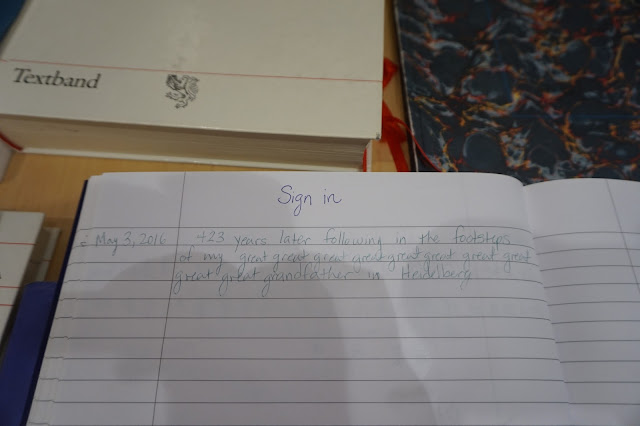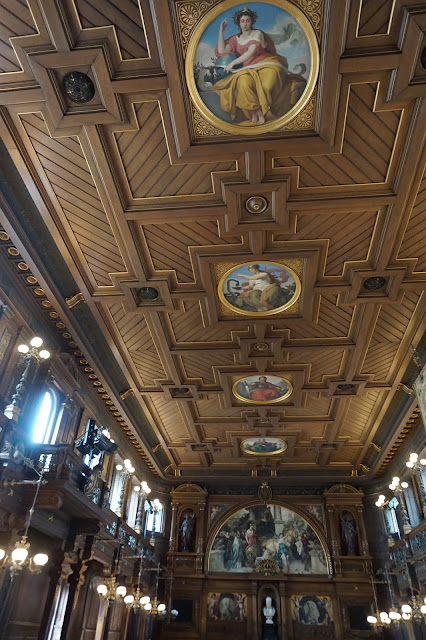"Semper Apertus" means "always open," and it is a reminder to the students to always be curious, to always be open to new ideas, and to remember that "always" means not only in the classroom but all around! Always keep the curiosity, always keep the openness, always keep looking, always keep listening! The book of learning is always open!
OK, now for a picture of the castle:
Though I've been drawn to posting about touristy stuff and rather neglecting writing about my mathematicians of late, each city I visit is on my itinerary because of its mathematical connections. There are many such connections in Heidelberg, and the person I'm most focused on here is Sonya Kovalevsky - another story of struggle and triumph by a female mathematician before the 20th century. I had opportunity to access manuscripts in the archives of Heidelberg University from the years she was here in order to seek out correspondence between her and professors she was auditing courses with, as she was not allowed to officially enroll, being a woman - four THICK volumes of documents in handwritten German from the 19th century, now THAT was a challenge! Anyway, more about her in a post dedicated to her.
I did have personal reasons for coming to Heideberg as well - some perhaps silly, others less so. Because my name is Heidi, my father-in-law nicknamed me "Heidelberg" and generally called me that. My father was in the printing business and used Heidelberg presses, so it was a name I saw a lot growing up. One of the confessions of my denomination is the Heidelberg Catechism, which was written here, and this leads me to the most important personal reason for coming here, and that is that my great-great-great-great-great-great-great-great-great-great-grandfather, Wibbo Hommens, attended Heidelberg University beginning in 1593. When he enrolled he changed his name to Homerus Wigboldus - latinised because he was a scholar I imagine.
The catechism was written in 1563 and when it was translated into Dutch, Grandpa Wibbo's father read it. He was so convinced of its truth that he decided his son needed to study at Heidelberg University where it had been written. This was at a time when the part of the Netherlands in which they were living was under Catholic Spanish rule - hence dangerous to be Protestant, and yet they pursued this route.
Sadly, none of the university buildings from the 1590s remain. The oldest university building existing today is from 1712. Heidelberg was hit hard in the Thirty Years War (1618-1648). Even the Alte Brucke (the "Old Bridge") wasn't here in his time - that came in 1788, nearly 200 years later!
But, he was surrounded by the hills I've been surrounded by while here, and the Neckar River flowed through the region then as it does now, and parts of the current (ruined) castle were present, though it probably had a rather different form than it does now. But, the university motto was then what it is now, as it was chosen in 1386: Semper Apertus!
He studied theology, which was considered the most important of the four disciplines, the others being law, medicine, and philosophy (under which mathematics was classified). In the "old"/current/1712 school hall, the ceiling is painted with images of the four disciplines - most important to least important - theology coming first, philosophy/mathematics coming last - hmm . . .
OK, a little heavy on the church history and family history there, but it was kind of a big deal for me to visit here. Moving on to miscellaneous pictures of Heidelberg.
This church looks rather different from those I saw in England or France!
It was BEAUTIFUL wherever I looked! I think this place wins the prize (so far) for most beautiful city I've seen. It's running neck-and-neck with Edinburgh - different types of beauty, though.
The climb to the castle was steep!
Hmm . . . probably shouldn't say anything about this . . .
I do like the seminar they have going on!
Looking back at the town from the Philosophenweg ("Philosopher's Way")

Hmm . . . probably shouldn't say anything about this . . .
While I was up walking along Philosopher's Way the 6:00 hour hit, and the church bells in town went NUTS and rang for like 15 minutes! It was very audible from where I was. I'm afraid it didn't come out as well as I'd hoped in the video, but listen for the bells - and the birds chiming in. (After the first 20 seconds or so you might want to just listen rather than watch, because it gets pretty shaky.)
Heiliggeistkirche:

More serendipity - I happened upon an organist practicing at Heiliggeistkirche -
































No comments:
Post a Comment